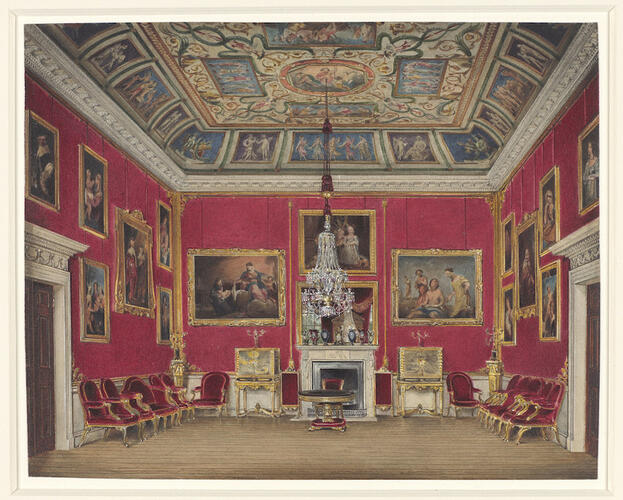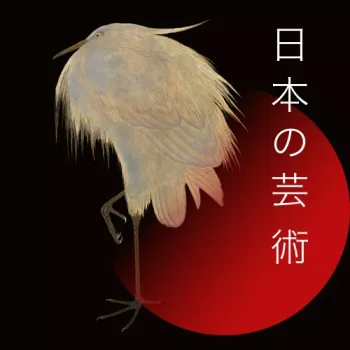The Second Drawing Room, Buckingham House 1818
Pencil, watercolour and bodycolour | 19.8 x 24.9 cm (sheet of paper) | RCIN 922143

James Stephanoff (1789-1874)
The Second Drawing Room, Buckingham House 1818
-
Buckingham House was bought by George III in 1761, and became the preferred London residence of the King and his consort, Queen Charlotte. The Second Drawing Room was one of the rooms in the Queen's apartment on the first floor of the west of 'garden front' of the house. The room (also known as the ‘Warm Room’: in 1802 it was one of only four rooms at Buckingham House to be carpeted) was located immediately to the north of the Crimson Drawing Room. It was the setting for Zoffany’s painting of the Prince of Wales and Prince Frederick, painted c.1765 soon after the completion of the King’s building works. That painting already shows the marble chimneypiece and (in reflection) the new doorcases designed by the King. However, the rococo overmantel mirror and seat furniture had been replaced by the time of Stephanoff’s view.
Zoffany’s painting does not include the ceiling, which may have been completed shortly before. It was painted by Cipriani to a surviving design by William Chamber . Notes on the design record that Cipriani was paid £225 for ‘17 pictures & 4 Genii’, while Charles Cotton received £120 for ‘painting in Gold and colour all the ornaments’, and the upholsterer Samuel Norman received 12 guineas ‘for pasting up the work’.
The paintings recorded by Stephanoff include portraits by Van Dyck also shown by Zoffany in the room fifty years before; the other paintings had all been in this room for thirty years and may be identified by the inventories of 1790 and 1819. The overdoors are portraits, a young man in the manner of Vouet (405550, left) and Lady D’Aubigny after Van Dyck (401360, right). The remainder of the left wall shows Van Dyck’s Villiers Boys (404401), flanked with Madonnas by Cantarini (405545, upper left) and Van Dyck (404639, upper right) and two Holy Families after Andrea del Sarto (402820, lower left & 406113, lower right). Van Dyck’s portrait of the three eldest children of Charles I (404403) hangs over the mantle opposite the windows, flanked by Cagnacci’s Jacob, Rachel and Leah (406088, left) and Maratta’s Virgin and Child with St Stanislaus Koska (405693, right). The right wall shows Van Dyck’s portrait of Kenelm Digby (402903), flanked by Maratta St Joseph (402881, upper left), Guercino Samarian Woman (406059, lower left), Guercino’s Sybil (405340, upper right) and Gennari’s portrait of Guercino (400533, lower right).
Stephanoff's painting depicts a pair of seventeenth-century Japanese lacquer cabinets, each with gold takamakie decoration and distinctive gilt clasp hinges, in pride of place on either side of the chimneypiece; these cabinets remain in the Royal Collection today (RCIN 21627). They were the height of luxury in Britain, and carved gilt stands were made to fit, setting them at a useable height. The chimneypiece was transferred to the Queen’s Presence Chamber at Windsor by William IV.
Catalogue entry adapted from George III & Queen Charlotte: Patronage, Collecting and Court Taste, London, 2004 and Japan: Courts and Culture (2020)Provenance
Probably acquired by George IV
-
Creator(s)
Acquirer(s)
-
Medium and techniques
Pencil, watercolour and bodycolour
Measurements
19.8 x 24.9 cm (sheet of paper)
Other number(s)
RL 22143Alternative title(s)
The second drawing room, Buckingham Palace.
Queen Charlotte's Dressing Room, later the Second Drawing Room at Buckingham House








